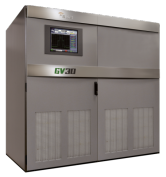Award-winning Nautel HD Multiplex is a spectrally efficient and energy efficient means to implement all-digital radio utilizing a multiplexed implementation of Xperi’s Gen4 HD Radio™ transmission technology. It enables the placement of up to 15 audio streams or stations within 600 kHz of signal bandwidth or up to nine audio streams in 400 kHz of signal bandwidth.

This new experimental technology allows the combination of multiple independent IBOC exgine modulators into a single HD PowerBoost crest factor reduction engine, permitting two or more IBOC stations to be amplified using a single transmitter and subsequent antenna system. Nautel’s HD PowerBoost™ uses an intelligent peak to average power ratio algorithm – PAPR – to increase HD Radio power output while at the same time increasing efficiency.
The all-digital IBOC configuration is capable of carrying up to three times the standard IBOC content. The methodology also maintains backward compatibility with existing receivers by ensuring the standard sideband channel separation within the multiplexed signal.
HD Multiplex builds on the advantages of existing IBOC technology. Existing IBOC can place up to five audio streams in the 200 kHz frequency partition dedicated to a single FM broadcast. Another IBOC advantage is its superior D/U ratio of only 4-6 dB compared to 20-30 dB in FM. This allows much better frequency re-use and short spacing of stations. HD Multiplex further increases the spectral efficiency by interleaving multiple IBOC signals and using all the allocated frequency space without any waste.
Comparable coverage to an FM transmitter would only require 60-75% of the FM transmitters TPO.
HD Multiplex is experimental and would require an exciter upgrade on existing IBOC/HD PowerBoost capable transmitter, and regulatory approval.
No pricing is currently available.
Potential Applications
- Enable the move of AM stations to the FM band, as proposed by some countries.
- Address current shortage of available frequencies in the FM band; 200+ audio channels could be possible with proper frequency planning.
- Stations considering HD conversion could test the waters by leasing an audio stream on another broadcaster’s multiplex.
- Netcasters could place their most popular streams on an over-the-air signal.
- Stations could use the added channels as a potential revenue source via leasing of audio streams, ad insertion or adding specialty channels such as sports or community information.
- Small markets could have a broad variety of diverse formats served by a single low-cost station.
Learn More
All Digital HD Multiplex Field Trial at KKLZ, Las Vegas (Presentation)
HD Multiplex FAQ (Document)
Digitizing Terrestrial Radio with HD Radio Multiplex (Presentation)
Interleaving IBOC Signals for a Digital HD Radio Multiplex (Presentation)
HD Multiplex (Presentation)
Interleaving IBOC Signals for a Digital HD Radio Multiplex by Philipp Schmid (White Paper)

